Once a curious oddity on the dragstrip, diesel-powered pickups can now be seen tearing down tracks all across North America. In addition to pickups, compact cars like Volkswagen Jettas and Golfs are starting to get in on the action, as well as diesel-powered sports sedans and SUVs. With the popularity of diesel drag racing at an all-time high, we've created a list of tips and tricks for beginners and intermediate racers, including some sound advice from the pros of the sport—those who drag race diesels on practically a weekly basis.
Before You Hit the Track
Drag racing your hot-rodded diesel rig actually starts well before you hit the dragstrip. Almost all dragstrips have a mandatory process called a tech inspection, which is a basic once-over of your vehicle (performed by a track official) to ensure whatever you're racing is safe. Such hazards as nails or screws in tires, a cracked windshield, batteries that aren't properly secured, fluid leaks, or excess mud, dirt, or gravel in the bed are all reasons why you might be sent home rather than to the starting line. Even having improper clothing for racing like shorts, sandals, or tank tops can have you running to Walmart for acceptable gear. While a helmet isn't required until you run 13.99 seconds or faster in the quarter-mile, even a 15- or 16-second ride has to be safe before you make a pass. It's always a good idea to check with the dragstrip first to see if there are any special rules for diesels (like exhaust turn-ups) before heading to the strip.
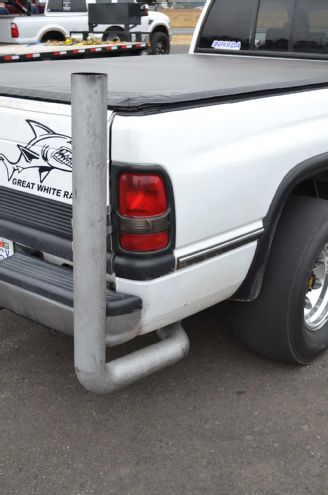
| It's a good idea to talk to a tech inspector before you race to see if there's any type of special equipment (such as this exhaust turn-up) that's needed for your diesel. The most common infractions that can get drivers sent home include excessive dirt (in wheelwells or a truck's bed), a cracked windshield, batteries that aren't secure, and engine oil/transmission fluid or water leaks.
The Staging Lanes and Starting Line
So you've gained entrance to the track and are ready to make your first run. After tech inspection, you'll most likely head to the pits. Please note that the pits are usually a pretty busy area, full of serious racers who might be unloading $100,000 cars. So, speeding, blowing smoke, or doing donuts is a definite no-no in the pit area. Just beyond the pit is an area called the staging lanes, where drag racers line up to race. Often, street vehicles will be designated a certain numbered lane, so make sure you know which lane you're supposed to be in before heading to the staging area. From there, it's just like rush-hour traffic: You sit in the staging lanes and move forward one lane at a time as more vehicles go down the dragstrip. Leaving your car or running your air conditioner (which creates condensation) is frowned upon, so make sure to stay close to your vehicle—and keep your A/C off—until it's your turn to go.
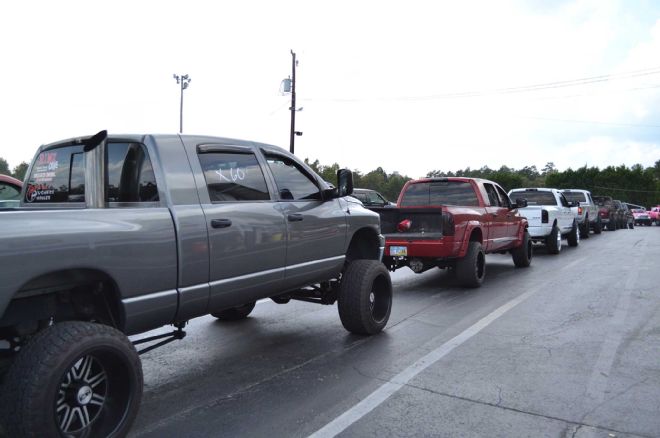
| The staging lane area at a dragstrip is almost like a truck show, so it's tempting to walk around and look at other people's rides. Stay close to your vehicle at all times, however, in case your lane moves. Also, have your air conditioner turned off and be ready to rock, with your helmet on, seatbelt fastened, and window up when it's time to race.
The Burnout Box and Staging
As you get close to the front of the line, you'll see a track official directing cars. Pay very close attention to this person, as he or she will be the one telling you which lane you need to be in and when to pull onto the track. At this point, your windows should be up, and you should be ready to race. Regardless of whether you're in a two-wheel-drive or four-wheel-drive rig, it's become common practice to pull around the water box that most tracks use for burnouts, then back into the puddle if you wish to do a burnout. After wetting the tires, you will be asked to pull forward slightly (maybe 6 inches or so), and then you can do a burnout of a few seconds to clean off the tires. Don't overdo it! While huge 300-foot burnouts may impress your friends, they'll earn you a warning from the starter. If you're done with your burnout or you just pulled around the water box and straight onto the track (common on four-wheel drives), then it's time to stage the truck at the starting line.
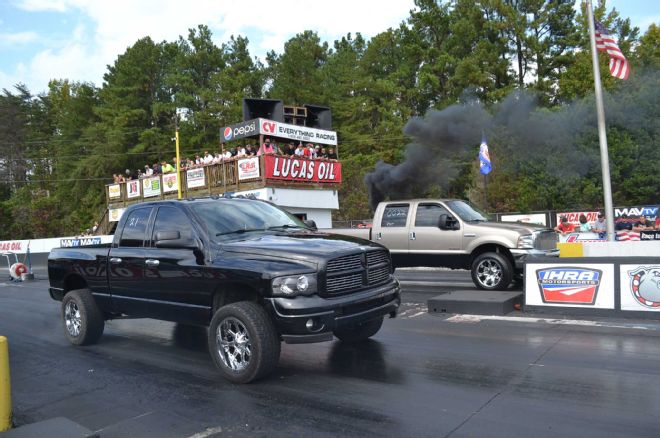
| When it's your turn to race, you'll pull up to the staging beams and start building boost. Best launches are usually achieved with between 5 psi and 15 psi, although it does vary from truck to truck. Trying to leave at 20 psi or more usually just results in spinning tires, wheelhop, breaking parts, or all three. Even on a stock truck, taking off in four-wheel drive (if you have it) will net about 0.5 seconds in e.t. reduction, although it should only be attempted on Chevrolet and GMC trucks if the tie rods and centerlink have been upgraded.
When pulling forward, note that the staging lights are actually in two small boxes on the ground, rather than up at the starting device that's better known as a "Christmas Tree." There are elements in the staging process. The first is "pre-stage" (the first yellow light at the top of the Christmas Tree is activated once the vehicle's tires break the first light beam that runs across the starting line), and then "staged," which occurs when a second light beam across the starting line is broken, which activates the second yellow bulb at the top of the Christmas Tree. The staged beacons are the starter's cue that a driver is ready for the green light.
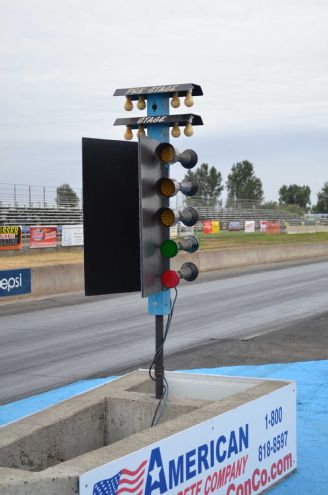
| A device known as a Christmas Tree starts a drag race, and it's good to get familiar with how it works before you ever go to the track. The top two lights that are pointed down toward the ground are known as the pre-stage and staging lights. These lights are activated by the vehicle's tire, and two bulbs lit on both sides means both drivers are ready to run. From there, the yellow lights facing the driver will either flash at half-second intervals (Sportsman Tree) or all at once (Pro Tree). Either way, the driver should leave on the last yellow. A green light will signal a good start, while a red light means the driver has jumped the start, which means a loss.
Your First Pass: Launch and Hold On!
Once both the pre-stage and stage bulbs are lit, the lights on the Christmas Tree will flash "yellow, yellow, yellow, green," at half-second intervals. This is called a Sportsman or .500 tree; the driver should leave on the last yellow. If your tires spin, just try and modulate the throttle as best as you can, rather than do a giant burnout. If you're in a four-wheel drive, the vehicle should just grip and go. If something happens during the pass like smoke, a pop, or bang, pull over to the side of the track near the guardrail as quickly as you can. Driving all the way down the dragstrip with leaking oil or antifreeze is a good way of making other racers very irritated with you.
Assuming everything goes right and your vehicle accelerates and shifts like it should, keep the hammer down until you cross the finish line, which should be indicated by a stripe or two orange timing lights in the middle of the track. At this point, let off, and start applying the brakes, but unless your truck is really fast, you probably don't need to stop abruptly. Once you've slowed, take the first turnout you can make to reach the return road, keeping in mind the vehicle in the lane nearest to the return road always has the right of way. From there, maintain a reasonable speed down the return road, and then collect your timeslip! Congratulations, you've just made your first pass.
Boosted Launches
If you're racing a four-wheel-drive (or two-wheel-drive with slicks or drag radials), then it's a good idea to start building boost as soon as both staging bulbs are lit, so you can launch under a good amount of power. While this is the best way to get quick elapsed times, it's also more difficult than one might think. After pulling up right before the pre-stage and staging lights, power-brake the truck (or car) so it builds about 5 psi of boost. Creep into the first staging beam by letting up slightly on the brake, until the pre-stage bulb is lit. At this point, the other competitor should be doing the same thing. Gradually give the vehicle a little more throttle and creep into the second beam.
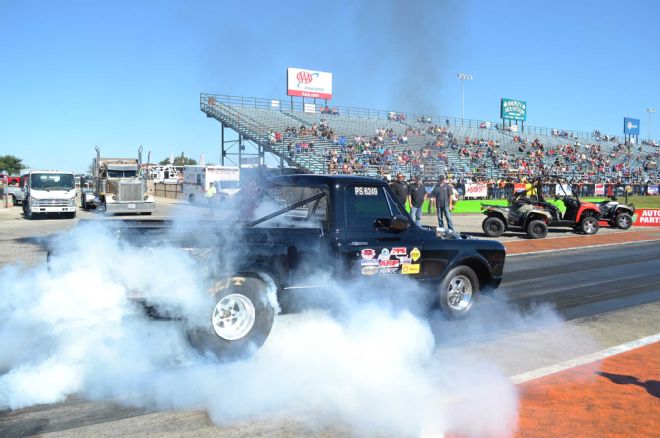
| If you have a two-wheel-drive truck or car, racing slicks will give you the best traction, especially as power rises. Even on 13- or 14-second rides, slicks can drop a full second off the vehicle's elapsed time.

| If you are using slicks, doing a healthy burnout will definitely help improve traction, but don't overdo it. Performing a long burnout past the starting line shouldn't be done unless you OK it with a track official first.
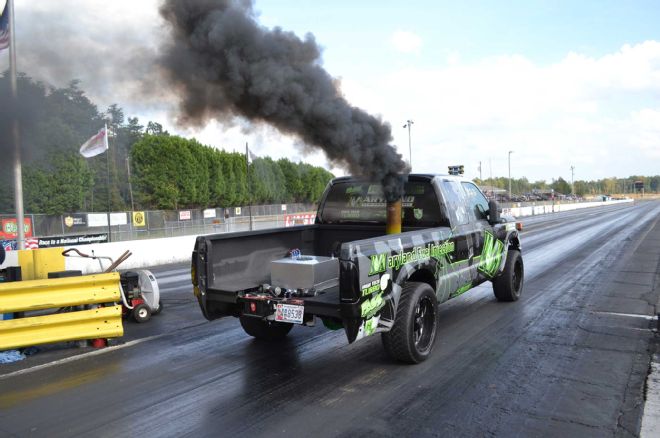
| In four-wheel drive, excellent traction can be achieved no matter what type of tread the tires have. This '10 Ford F-250 built by Maryland Performance Diesel was able to run mid-6s in the eighth-mile on simple street tires.
At this point, you should be at about 10 to 15 psi of boost and ready to launch. If something goes wrong with the other competitor or the tree doesn't activate, don't just sit there against the torque converter, as this could result in serious transmission damage. If everything goes right and you're able to leave on the last yellow, floor the throttle rather quickly while stepping off the brake as fast as you can to achieve the best launch. Once you've mastered leaving the line with boost, you can start raising the boost levels to determine when the vehicle breaks traction. Diesels make so much torque that virtually no oil-burning truck or car (even all-out racing vehicles) can leave the line at maximum boost. Also, keep in mind that leaving the line hard can result in transmission, driveline, or suspension breakage, so play at your own risk when it comes to taking off with a good amount of boost.
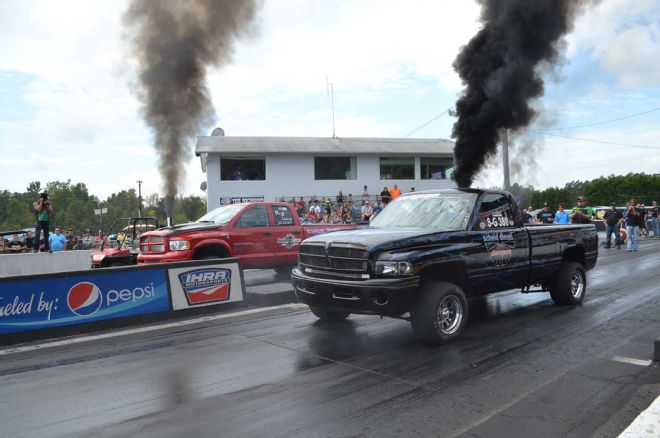
| The first 60 feet is often considered the most difficult part of a run. In four-wheel drive, expect the truck to pull a little to the right or left, which will require some steering input. Once the vehicle is down track a good way, just hang on until the end. If you hear any pops or bangs, it's best to pull off to the side of the dragstrip, in case the vehicle is spilling any fluid.
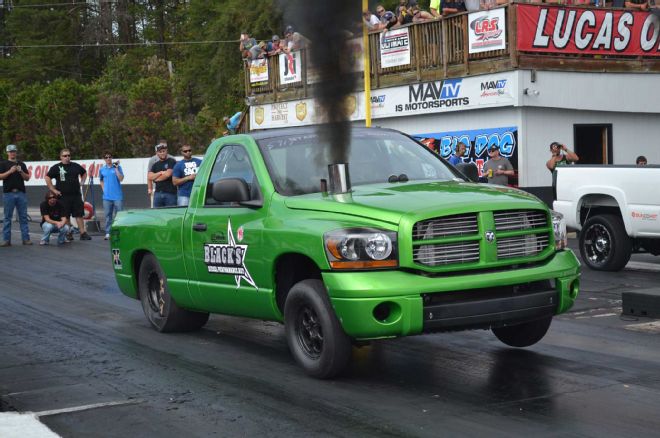
| A dedicated diesel race truck can leave the light at 15 psi of boost or more, but it should have a dedicated transmission, driveline, and rearend that can handle the stress of high-boost launches.
Drivetrain and Chassis Tuning
The first pass you make will hardly be your best. There are many ways to whittle down your elapsed time while still running the same basic setup. For instance, we know of one driver who picked up a tenth of a second after creating his own ram-air system. Another picked up two tenths by removing unnecessary weight from his truck. A third competitor picked up three tenths by experimenting with suspension, tire pressure, and boost during the launch. A fourth was able to adjust the rate of torque converter lockup and gained two tenths. The point is, adding huge injectors and a big turbo might not be what you actually need to run the elapsed time you want, and all those tenths that come from refining a combination add up!
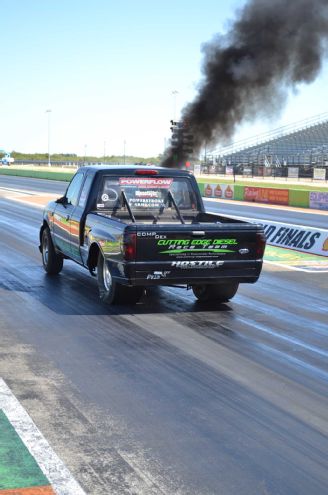
| Building a lightweight vehicle is a good way to ward off parts breakage and go fast at the dragstrip. This 6.0L-powered '03 Ford Ranger built by Cutting Edge Diesel has broken into the 9.30s in the quarter-mile, thanks in part to its sub-5,000 pound race weight.
Final Thoughts
It makes no difference whether you drive an 8- or an 18-second truck, diesel drag racing can be fun for just about any competitor. Just like sled pulling, drag racing is meant to be a fun family activity, so don't be nervous about asking fellow competitors for advice. Having a combination where everything matches (such as the torque converter stall speed and turbocharger size) is perhaps the most important aspect of diesel drag racing, so make sure to do your homework before you make any big changes. Now get out there and have some fun! There's nothing like beating muscle cars in a 4-ton truck!
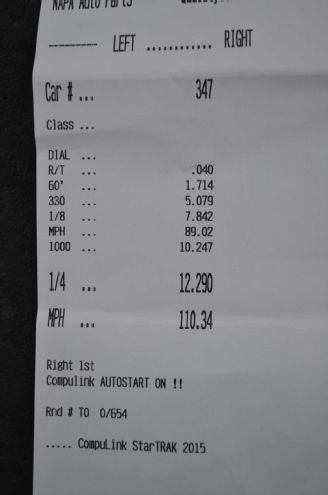
| After your run, you'll receive a timeslip that gives you elapsed time and speed results, but it also has a bunch of other useful information. "R/T" is your reaction time to the green light, your 60-foot time can be used as an indicator of traction, and both eighth-mile and quarter-mile times and speeds are given. On this timeslip, a reaction time of .040 (with .000 being "perfect," this is a very good reaction time), 60-foot time of 1.71 seconds, eighth-mile time of 7.84 seconds at 89 mph, and quarter-mile time of 12.29 at 110 mph all indicate everything was working well on this pass.
Tips from the Pros
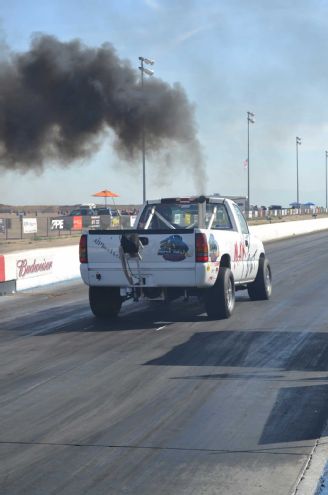
| Idaho Rob
"Before you start adding power, get used to your truck and how it goes down the dragstrip. Be as consistent as possible with your current combination; that way you'll already know how to drive it once you turn the power up." —"Idaho" Rob Coddens, NHRDA Super Street Record Holder (9.47 at 152 mph), 2013 Super Street Champion
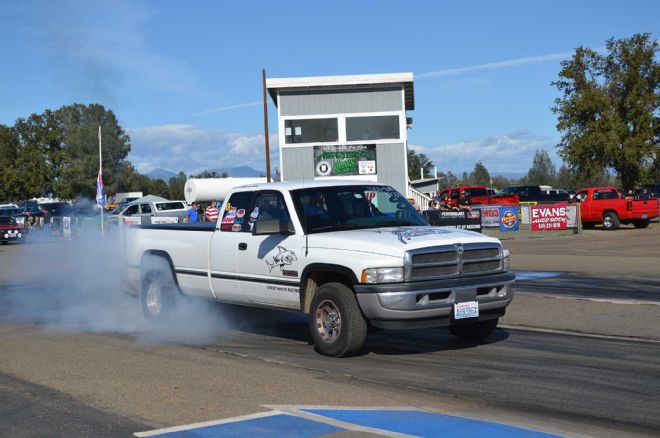
| Jim Calhoun
"Diesels can be very consistent drag race vehicles at moderate power levels. My truck has made 457 hp at the rear wheels, runs low 13s, and I have about 800 dragstrip passes on it since 2004. I've gone from Washington to Indianapolis to race and then driven it back home." —Jim Calhoun, winningest driver in NHRDA history
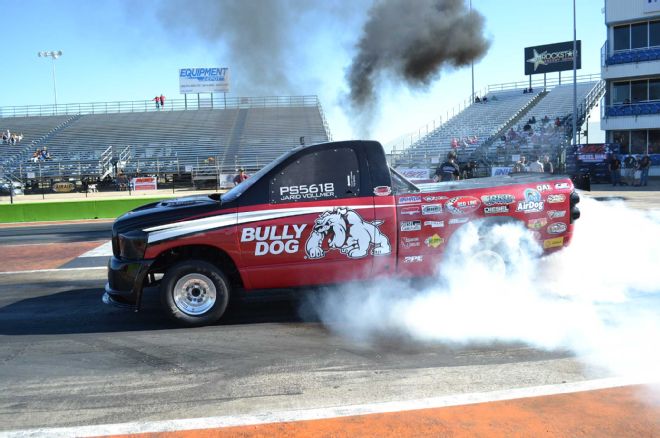
| Jarid Vollmer
"It's tempting to just put a diesel drag vehicle in the trailer after a race, but proper maintenance is very critical. It's better to catch a problem right after a race than a few days before the next one."—Jarid Vollmer, NHRDA Pro Street record holder (8.51 seconds at 160 mph) and three-time Pro Street Champion
 | It's a good idea to talk to a tech inspector before you race to see if there's any type of special equipment (such as this exhaust turn-up) that's needed for your diesel. The most common infractions that can get drivers sent home include excessive dirt (in wheelwells or a truck's bed), a cracked windshield, batteries that aren't secure, and engine oil/transmission fluid or water leaks.
The Staging Lanes and Starting Line
So you've gained entrance to the track and are ready to make your first run. After tech inspection, you'll most likely head to the pits. Please note that the pits are usually a pretty busy area, full of serious racers who might be unloading $100,000 cars. So, speeding, blowing smoke, or doing donuts is a definite no-no in the pit area. Just beyond the pit is an area called the staging lanes, where drag racers line up to race. Often, street vehicles will be designated a certain numbered lane, so make sure you know which lane you're supposed to be in before heading to the staging area. From there, it's just like rush-hour traffic: You sit in the staging lanes and move forward one lane at a time as more vehicles go down the dragstrip. Leaving your car or running your air conditioner (which creates condensation) is frowned upon, so make sure to stay close to your vehicle—and keep your A/C off—until it's your turn to go.
| It's a good idea to talk to a tech inspector before you race to see if there's any type of special equipment (such as this exhaust turn-up) that's needed for your diesel. The most common infractions that can get drivers sent home include excessive dirt (in wheelwells or a truck's bed), a cracked windshield, batteries that aren't secure, and engine oil/transmission fluid or water leaks.
The Staging Lanes and Starting Line
So you've gained entrance to the track and are ready to make your first run. After tech inspection, you'll most likely head to the pits. Please note that the pits are usually a pretty busy area, full of serious racers who might be unloading $100,000 cars. So, speeding, blowing smoke, or doing donuts is a definite no-no in the pit area. Just beyond the pit is an area called the staging lanes, where drag racers line up to race. Often, street vehicles will be designated a certain numbered lane, so make sure you know which lane you're supposed to be in before heading to the staging area. From there, it's just like rush-hour traffic: You sit in the staging lanes and move forward one lane at a time as more vehicles go down the dragstrip. Leaving your car or running your air conditioner (which creates condensation) is frowned upon, so make sure to stay close to your vehicle—and keep your A/C off—until it's your turn to go.
 | The staging lane area at a dragstrip is almost like a truck show, so it's tempting to walk around and look at other people's rides. Stay close to your vehicle at all times, however, in case your lane moves. Also, have your air conditioner turned off and be ready to rock, with your helmet on, seatbelt fastened, and window up when it's time to race.
The Burnout Box and Staging
As you get close to the front of the line, you'll see a track official directing cars. Pay very close attention to this person, as he or she will be the one telling you which lane you need to be in and when to pull onto the track. At this point, your windows should be up, and you should be ready to race. Regardless of whether you're in a two-wheel-drive or four-wheel-drive rig, it's become common practice to pull around the water box that most tracks use for burnouts, then back into the puddle if you wish to do a burnout. After wetting the tires, you will be asked to pull forward slightly (maybe 6 inches or so), and then you can do a burnout of a few seconds to clean off the tires. Don't overdo it! While huge 300-foot burnouts may impress your friends, they'll earn you a warning from the starter. If you're done with your burnout or you just pulled around the water box and straight onto the track (common on four-wheel drives), then it's time to stage the truck at the starting line.
| The staging lane area at a dragstrip is almost like a truck show, so it's tempting to walk around and look at other people's rides. Stay close to your vehicle at all times, however, in case your lane moves. Also, have your air conditioner turned off and be ready to rock, with your helmet on, seatbelt fastened, and window up when it's time to race.
The Burnout Box and Staging
As you get close to the front of the line, you'll see a track official directing cars. Pay very close attention to this person, as he or she will be the one telling you which lane you need to be in and when to pull onto the track. At this point, your windows should be up, and you should be ready to race. Regardless of whether you're in a two-wheel-drive or four-wheel-drive rig, it's become common practice to pull around the water box that most tracks use for burnouts, then back into the puddle if you wish to do a burnout. After wetting the tires, you will be asked to pull forward slightly (maybe 6 inches or so), and then you can do a burnout of a few seconds to clean off the tires. Don't overdo it! While huge 300-foot burnouts may impress your friends, they'll earn you a warning from the starter. If you're done with your burnout or you just pulled around the water box and straight onto the track (common on four-wheel drives), then it's time to stage the truck at the starting line.
 | When it's your turn to race, you'll pull up to the staging beams and start building boost. Best launches are usually achieved with between 5 psi and 15 psi, although it does vary from truck to truck. Trying to leave at 20 psi or more usually just results in spinning tires, wheelhop, breaking parts, or all three. Even on a stock truck, taking off in four-wheel drive (if you have it) will net about 0.5 seconds in e.t. reduction, although it should only be attempted on Chevrolet and GMC trucks if the tie rods and centerlink have been upgraded.
When pulling forward, note that the staging lights are actually in two small boxes on the ground, rather than up at the starting device that's better known as a "Christmas Tree." There are elements in the staging process. The first is "pre-stage" (the first yellow light at the top of the Christmas Tree is activated once the vehicle's tires break the first light beam that runs across the starting line), and then "staged," which occurs when a second light beam across the starting line is broken, which activates the second yellow bulb at the top of the Christmas Tree. The staged beacons are the starter's cue that a driver is ready for the green light.
| When it's your turn to race, you'll pull up to the staging beams and start building boost. Best launches are usually achieved with between 5 psi and 15 psi, although it does vary from truck to truck. Trying to leave at 20 psi or more usually just results in spinning tires, wheelhop, breaking parts, or all three. Even on a stock truck, taking off in four-wheel drive (if you have it) will net about 0.5 seconds in e.t. reduction, although it should only be attempted on Chevrolet and GMC trucks if the tie rods and centerlink have been upgraded.
When pulling forward, note that the staging lights are actually in two small boxes on the ground, rather than up at the starting device that's better known as a "Christmas Tree." There are elements in the staging process. The first is "pre-stage" (the first yellow light at the top of the Christmas Tree is activated once the vehicle's tires break the first light beam that runs across the starting line), and then "staged," which occurs when a second light beam across the starting line is broken, which activates the second yellow bulb at the top of the Christmas Tree. The staged beacons are the starter's cue that a driver is ready for the green light.
 | A device known as a Christmas Tree starts a drag race, and it's good to get familiar with how it works before you ever go to the track. The top two lights that are pointed down toward the ground are known as the pre-stage and staging lights. These lights are activated by the vehicle's tire, and two bulbs lit on both sides means both drivers are ready to run. From there, the yellow lights facing the driver will either flash at half-second intervals (Sportsman Tree) or all at once (Pro Tree). Either way, the driver should leave on the last yellow. A green light will signal a good start, while a red light means the driver has jumped the start, which means a loss.
Your First Pass: Launch and Hold On!
Once both the pre-stage and stage bulbs are lit, the lights on the Christmas Tree will flash "yellow, yellow, yellow, green," at half-second intervals. This is called a Sportsman or .500 tree; the driver should leave on the last yellow. If your tires spin, just try and modulate the throttle as best as you can, rather than do a giant burnout. If you're in a four-wheel drive, the vehicle should just grip and go. If something happens during the pass like smoke, a pop, or bang, pull over to the side of the track near the guardrail as quickly as you can. Driving all the way down the dragstrip with leaking oil or antifreeze is a good way of making other racers very irritated with you.
Assuming everything goes right and your vehicle accelerates and shifts like it should, keep the hammer down until you cross the finish line, which should be indicated by a stripe or two orange timing lights in the middle of the track. At this point, let off, and start applying the brakes, but unless your truck is really fast, you probably don't need to stop abruptly. Once you've slowed, take the first turnout you can make to reach the return road, keeping in mind the vehicle in the lane nearest to the return road always has the right of way. From there, maintain a reasonable speed down the return road, and then collect your timeslip! Congratulations, you've just made your first pass.
Boosted Launches
If you're racing a four-wheel-drive (or two-wheel-drive with slicks or drag radials), then it's a good idea to start building boost as soon as both staging bulbs are lit, so you can launch under a good amount of power. While this is the best way to get quick elapsed times, it's also more difficult than one might think. After pulling up right before the pre-stage and staging lights, power-brake the truck (or car) so it builds about 5 psi of boost. Creep into the first staging beam by letting up slightly on the brake, until the pre-stage bulb is lit. At this point, the other competitor should be doing the same thing. Gradually give the vehicle a little more throttle and creep into the second beam.
| A device known as a Christmas Tree starts a drag race, and it's good to get familiar with how it works before you ever go to the track. The top two lights that are pointed down toward the ground are known as the pre-stage and staging lights. These lights are activated by the vehicle's tire, and two bulbs lit on both sides means both drivers are ready to run. From there, the yellow lights facing the driver will either flash at half-second intervals (Sportsman Tree) or all at once (Pro Tree). Either way, the driver should leave on the last yellow. A green light will signal a good start, while a red light means the driver has jumped the start, which means a loss.
Your First Pass: Launch and Hold On!
Once both the pre-stage and stage bulbs are lit, the lights on the Christmas Tree will flash "yellow, yellow, yellow, green," at half-second intervals. This is called a Sportsman or .500 tree; the driver should leave on the last yellow. If your tires spin, just try and modulate the throttle as best as you can, rather than do a giant burnout. If you're in a four-wheel drive, the vehicle should just grip and go. If something happens during the pass like smoke, a pop, or bang, pull over to the side of the track near the guardrail as quickly as you can. Driving all the way down the dragstrip with leaking oil or antifreeze is a good way of making other racers very irritated with you.
Assuming everything goes right and your vehicle accelerates and shifts like it should, keep the hammer down until you cross the finish line, which should be indicated by a stripe or two orange timing lights in the middle of the track. At this point, let off, and start applying the brakes, but unless your truck is really fast, you probably don't need to stop abruptly. Once you've slowed, take the first turnout you can make to reach the return road, keeping in mind the vehicle in the lane nearest to the return road always has the right of way. From there, maintain a reasonable speed down the return road, and then collect your timeslip! Congratulations, you've just made your first pass.
Boosted Launches
If you're racing a four-wheel-drive (or two-wheel-drive with slicks or drag radials), then it's a good idea to start building boost as soon as both staging bulbs are lit, so you can launch under a good amount of power. While this is the best way to get quick elapsed times, it's also more difficult than one might think. After pulling up right before the pre-stage and staging lights, power-brake the truck (or car) so it builds about 5 psi of boost. Creep into the first staging beam by letting up slightly on the brake, until the pre-stage bulb is lit. At this point, the other competitor should be doing the same thing. Gradually give the vehicle a little more throttle and creep into the second beam.
 | If you have a two-wheel-drive truck or car, racing slicks will give you the best traction, especially as power rises. Even on 13- or 14-second rides, slicks can drop a full second off the vehicle's elapsed time.
| If you have a two-wheel-drive truck or car, racing slicks will give you the best traction, especially as power rises. Even on 13- or 14-second rides, slicks can drop a full second off the vehicle's elapsed time.
 | If you are using slicks, doing a healthy burnout will definitely help improve traction, but don't overdo it. Performing a long burnout past the starting line shouldn't be done unless you OK it with a track official first.
| If you are using slicks, doing a healthy burnout will definitely help improve traction, but don't overdo it. Performing a long burnout past the starting line shouldn't be done unless you OK it with a track official first.
 | In four-wheel drive, excellent traction can be achieved no matter what type of tread the tires have. This '10 Ford F-250 built by Maryland Performance Diesel was able to run mid-6s in the eighth-mile on simple street tires.
At this point, you should be at about 10 to 15 psi of boost and ready to launch. If something goes wrong with the other competitor or the tree doesn't activate, don't just sit there against the torque converter, as this could result in serious transmission damage. If everything goes right and you're able to leave on the last yellow, floor the throttle rather quickly while stepping off the brake as fast as you can to achieve the best launch. Once you've mastered leaving the line with boost, you can start raising the boost levels to determine when the vehicle breaks traction. Diesels make so much torque that virtually no oil-burning truck or car (even all-out racing vehicles) can leave the line at maximum boost. Also, keep in mind that leaving the line hard can result in transmission, driveline, or suspension breakage, so play at your own risk when it comes to taking off with a good amount of boost.
| In four-wheel drive, excellent traction can be achieved no matter what type of tread the tires have. This '10 Ford F-250 built by Maryland Performance Diesel was able to run mid-6s in the eighth-mile on simple street tires.
At this point, you should be at about 10 to 15 psi of boost and ready to launch. If something goes wrong with the other competitor or the tree doesn't activate, don't just sit there against the torque converter, as this could result in serious transmission damage. If everything goes right and you're able to leave on the last yellow, floor the throttle rather quickly while stepping off the brake as fast as you can to achieve the best launch. Once you've mastered leaving the line with boost, you can start raising the boost levels to determine when the vehicle breaks traction. Diesels make so much torque that virtually no oil-burning truck or car (even all-out racing vehicles) can leave the line at maximum boost. Also, keep in mind that leaving the line hard can result in transmission, driveline, or suspension breakage, so play at your own risk when it comes to taking off with a good amount of boost.
 | The first 60 feet is often considered the most difficult part of a run. In four-wheel drive, expect the truck to pull a little to the right or left, which will require some steering input. Once the vehicle is down track a good way, just hang on until the end. If you hear any pops or bangs, it's best to pull off to the side of the dragstrip, in case the vehicle is spilling any fluid.
| The first 60 feet is often considered the most difficult part of a run. In four-wheel drive, expect the truck to pull a little to the right or left, which will require some steering input. Once the vehicle is down track a good way, just hang on until the end. If you hear any pops or bangs, it's best to pull off to the side of the dragstrip, in case the vehicle is spilling any fluid.
 | A dedicated diesel race truck can leave the light at 15 psi of boost or more, but it should have a dedicated transmission, driveline, and rearend that can handle the stress of high-boost launches.
Drivetrain and Chassis Tuning
The first pass you make will hardly be your best. There are many ways to whittle down your elapsed time while still running the same basic setup. For instance, we know of one driver who picked up a tenth of a second after creating his own ram-air system. Another picked up two tenths by removing unnecessary weight from his truck. A third competitor picked up three tenths by experimenting with suspension, tire pressure, and boost during the launch. A fourth was able to adjust the rate of torque converter lockup and gained two tenths. The point is, adding huge injectors and a big turbo might not be what you actually need to run the elapsed time you want, and all those tenths that come from refining a combination add up!
| A dedicated diesel race truck can leave the light at 15 psi of boost or more, but it should have a dedicated transmission, driveline, and rearend that can handle the stress of high-boost launches.
Drivetrain and Chassis Tuning
The first pass you make will hardly be your best. There are many ways to whittle down your elapsed time while still running the same basic setup. For instance, we know of one driver who picked up a tenth of a second after creating his own ram-air system. Another picked up two tenths by removing unnecessary weight from his truck. A third competitor picked up three tenths by experimenting with suspension, tire pressure, and boost during the launch. A fourth was able to adjust the rate of torque converter lockup and gained two tenths. The point is, adding huge injectors and a big turbo might not be what you actually need to run the elapsed time you want, and all those tenths that come from refining a combination add up!
 | Building a lightweight vehicle is a good way to ward off parts breakage and go fast at the dragstrip. This 6.0L-powered '03 Ford Ranger built by Cutting Edge Diesel has broken into the 9.30s in the quarter-mile, thanks in part to its sub-5,000 pound race weight.
Final Thoughts
It makes no difference whether you drive an 8- or an 18-second truck, diesel drag racing can be fun for just about any competitor. Just like sled pulling, drag racing is meant to be a fun family activity, so don't be nervous about asking fellow competitors for advice. Having a combination where everything matches (such as the torque converter stall speed and turbocharger size) is perhaps the most important aspect of diesel drag racing, so make sure to do your homework before you make any big changes. Now get out there and have some fun! There's nothing like beating muscle cars in a 4-ton truck!
| Building a lightweight vehicle is a good way to ward off parts breakage and go fast at the dragstrip. This 6.0L-powered '03 Ford Ranger built by Cutting Edge Diesel has broken into the 9.30s in the quarter-mile, thanks in part to its sub-5,000 pound race weight.
Final Thoughts
It makes no difference whether you drive an 8- or an 18-second truck, diesel drag racing can be fun for just about any competitor. Just like sled pulling, drag racing is meant to be a fun family activity, so don't be nervous about asking fellow competitors for advice. Having a combination where everything matches (such as the torque converter stall speed and turbocharger size) is perhaps the most important aspect of diesel drag racing, so make sure to do your homework before you make any big changes. Now get out there and have some fun! There's nothing like beating muscle cars in a 4-ton truck!
 | After your run, you'll receive a timeslip that gives you elapsed time and speed results, but it also has a bunch of other useful information. "R/T" is your reaction time to the green light, your 60-foot time can be used as an indicator of traction, and both eighth-mile and quarter-mile times and speeds are given. On this timeslip, a reaction time of .040 (with .000 being "perfect," this is a very good reaction time), 60-foot time of 1.71 seconds, eighth-mile time of 7.84 seconds at 89 mph, and quarter-mile time of 12.29 at 110 mph all indicate everything was working well on this pass.
Tips from the Pros
| After your run, you'll receive a timeslip that gives you elapsed time and speed results, but it also has a bunch of other useful information. "R/T" is your reaction time to the green light, your 60-foot time can be used as an indicator of traction, and both eighth-mile and quarter-mile times and speeds are given. On this timeslip, a reaction time of .040 (with .000 being "perfect," this is a very good reaction time), 60-foot time of 1.71 seconds, eighth-mile time of 7.84 seconds at 89 mph, and quarter-mile time of 12.29 at 110 mph all indicate everything was working well on this pass.
Tips from the Pros
 | Idaho Rob
"Before you start adding power, get used to your truck and how it goes down the dragstrip. Be as consistent as possible with your current combination; that way you'll already know how to drive it once you turn the power up." —"Idaho" Rob Coddens, NHRDA Super Street Record Holder (9.47 at 152 mph), 2013 Super Street Champion
| Idaho Rob
"Before you start adding power, get used to your truck and how it goes down the dragstrip. Be as consistent as possible with your current combination; that way you'll already know how to drive it once you turn the power up." —"Idaho" Rob Coddens, NHRDA Super Street Record Holder (9.47 at 152 mph), 2013 Super Street Champion
 | Jim Calhoun
"Diesels can be very consistent drag race vehicles at moderate power levels. My truck has made 457 hp at the rear wheels, runs low 13s, and I have about 800 dragstrip passes on it since 2004. I've gone from Washington to Indianapolis to race and then driven it back home." —Jim Calhoun, winningest driver in NHRDA history
| Jim Calhoun
"Diesels can be very consistent drag race vehicles at moderate power levels. My truck has made 457 hp at the rear wheels, runs low 13s, and I have about 800 dragstrip passes on it since 2004. I've gone from Washington to Indianapolis to race and then driven it back home." —Jim Calhoun, winningest driver in NHRDA history
 | Jarid Vollmer
"It's tempting to just put a diesel drag vehicle in the trailer after a race, but proper maintenance is very critical. It's better to catch a problem right after a race than a few days before the next one."—Jarid Vollmer, NHRDA Pro Street record holder (8.51 seconds at 160 mph) and three-time Pro Street Champion
| Jarid Vollmer
"It's tempting to just put a diesel drag vehicle in the trailer after a race, but proper maintenance is very critical. It's better to catch a problem right after a race than a few days before the next one."—Jarid Vollmer, NHRDA Pro Street record holder (8.51 seconds at 160 mph) and three-time Pro Street Champion